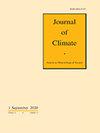ENSO干扰北方冬季CRE反馈
IF 4.8
2区 地球科学
Q1 METEOROLOGY & ATMOSPHERIC SCIENCES
引用次数: 0
摘要
二十年的卫星云和辐射观测使我们能够检验观测到的云辐射效应(CRE)反馈(即全球平均地表温度每单位变化的CRE变化)。通过采用分解方法分离不同云态(CR)组的“内部变化”和“相对出现频率变化”的贡献,出现了显著的CRE反馈特征的季节差异。寒带冬季CRE反馈以海洋低厚云的短波正反馈(SWCRE)为主,其RFO随温度升高而减小。这个信号很可能是由于厄尔尼诺Niño-Southern振荡(ENSO)活动。当排除ENSO信号时,北方冬季的CRE反馈在质量上与北方夏季的CRE反馈相似,其中几个CR组对总CRE反馈的贡献更均匀。大多数CR群的CRE反馈主要来自于RFO的变化:例如,从海洋积云到破碎云的主要转变以及温度变暖的高对流云的更多出现。与此同时,低厚云和破碎云的光学变薄和云分减少,这些特征在北方夏季比冬季更为突出。总的来说,主要由ENSO引起的CRE反馈的季节性不对称模式增加了CRE反馈评估的复杂性。本文章由计算机程序翻译,如有差异,请以英文原文为准。
ENSO Disrupts Boreal Winter CRE Feedback
Abstract Twenty years of satellite-based cloud and radiation observations allow us to examine the observed cloud radiative effect (CRE) feedback (i.e., CRE change per unit change in global mean surface temperature). By employing a decomposition method to separate the contribution of “internal changes” and “relative-frequency-of-occurrence (RFO) changes” of distinct cloud regime (CR) groups, notable seasonal contrasts of CRE feedback characteristics emerge. Boreal winter CRE feedback is dominated by the positive shortwave CRE (SWCRE) feedback of oceanic low-thick clouds, due to their decreasing RFO as temperature rises. This signal is most likely due to El Niño-Southern Oscillation (ENSO) activity. When ENSO signals are excluded, boreal winter CRE feedback becomes qualitatively similar to the boreal summer feedback, where several CR groups contribute to the total CRE feedback more evenly. Most CR groups’ CRE feedbacks largely come from changing RFO: e.g., the predominant transition from oceanic cumulus to broken clouds and more occurrences of higher convective clouds with warming temperature. At the same time, low-thick and broken clouds experience optical thinning and decreasing cloud fraction, and these features are more prominent in boreal summer than winter. Overall, the seasonally asymmetric patterns of CRE feedback, primarily due to ENSO, introduce complexity in assessments of CRE feedback.
求助全文
通过发布文献求助,成功后即可免费获取论文全文。
去求助
来源期刊

Journal of Climate
地学-气象与大气科学
CiteScore
9.30
自引率
14.30%
发文量
490
审稿时长
7.5 months
期刊介绍:
The Journal of Climate (JCLI) (ISSN: 0894-8755; eISSN: 1520-0442) publishes research that advances basic understanding of the dynamics and physics of the climate system on large spatial scales, including variability of the atmosphere, oceans, land surface, and cryosphere; past, present, and projected future changes in the climate system; and climate simulation and prediction.
 求助内容:
求助内容: 应助结果提醒方式:
应助结果提醒方式:


